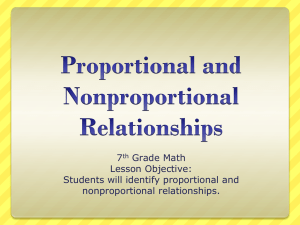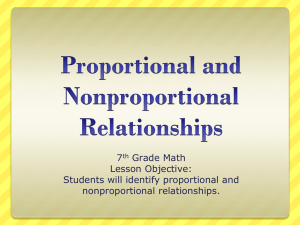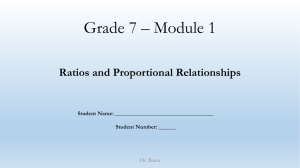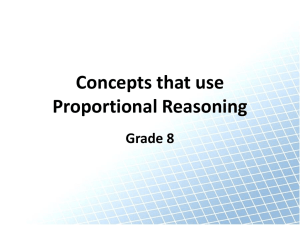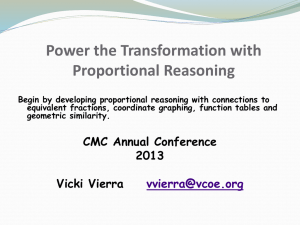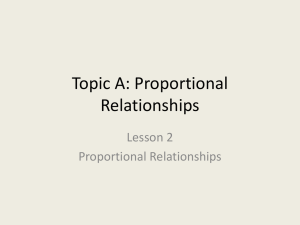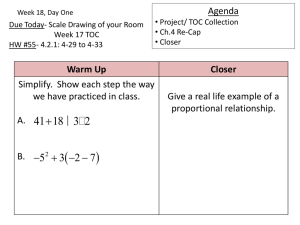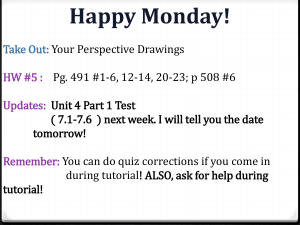Grade 7 * Module 1
advertisement
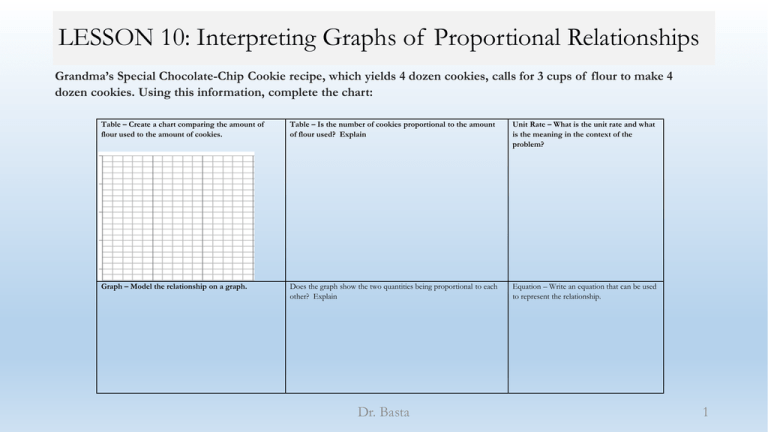
LESSON 10: Interpreting Graphs of Proportional Relationships Grandma’s Special Chocolate-Chip Cookie recipe, which yields 4 dozen cookies, calls for 3 cups of flour to make 4 dozen cookies. Using this information, complete the chart: Table – Create a chart comparing the amount of flour used to the amount of cookies. Table – Is the number of cookies proportional to the amount of flour used? Explain Unit Rate – What is the unit rate and what is the meaning in the context of the problem? Graph – Model the relationship on a graph. Does the graph show the two quantities being proportional to each other? Explain Equation – Write an equation that can be used to represent the relationship. Dr. Basta 1 LESSON 10: Interpreting Graphs of Proportional Relationships Below is a graph modeling the amount of sugar required to make Grandma’s Chocolate Chip Cookies. Record the coordinates of flour of the points from the graph in a table. What do these ordered pairs (values) represent? Grandma has 1 remaining cup of sugar. How many dozen cookies will she be able to make? Plot the point on the graph above. How many dozen cookies can grandma make if she has no sugar? Can you graph this on the grid provided above? What do we call this point? Dr. Basta 2 LESSON 10: Interpreting Graphs of Proportional Relationships • How is the unit rate related to the graph? _______________________________________________________ • What quantity is measured along the horizontal axis? ______________________________________________ • When you plot the ordered pair (𝐴, 𝐵), what does 𝐴 represent? ______________________________________ • What quantity is measured along the vertical axis? ________________________________________________ • When you plot the point (𝐴, 𝐵), what does 𝐵 represent? ___________________________________________ • What is the unit rate for this proportional relationship? ____________________________________________ • Starting at the origin, if you move one unit along the horizontal axis, how far would you have to move vertically to reach the line you graphed? __________________________________________________________________ • Why are we always moving 1.5 units vertically? ___________________________________________________ • Continue moving one unit at a time along the horizontal axis. What distance vertically do you move? _________ • Does this number look familiar? Is it the unit rate? Do you think this will always be the case, whenever two quantities that are proportional are graphed? _____________________________________________________ • Graphs of different proportional relationship have different points, but what point must be on every graph of a proportional relationship? Explain why. _______________________________________________________ Dr. Basta 3 LESSON 10: Interpreting Graphs of Proportional Relationships The graph below shows the amount of time a person can shower with a certain amount of water. • Can you determine by looking at the graph whether the length of the shower is proportional to the number of gallons of water? Explain how you know. • How long can a person shower with 15 gallons of water and with 60 gallons of water? • What are the coordinates of point A? Describe point A in the context of the problem. • Can you use the graph to identify the unit rate? • Plot the unit rate on the graph. Is the point on the line of this relationship? • Write the equation to represent the relationship between the number of gallons used and the length of a shower. Dr. Basta 4 LESSON 10: Interpreting Graphs of Proportional Relationships Your friend uses the equation 𝐶 = 50𝑃 to find the total cost of P people entering the local Amusement Park. • Create a table and record the cost of entering the amusement park for several different-sized groups of people. • Is the cost of admission proportional to the amount of people entering the Amusement Park? Explain why or why not. • What is the unit rate and what does it represent in the context of the situation? • Sketch a graph to represent this relationship Dr. Basta 5 LESSON 10: Interpreting Graphs of Proportional Relationships Your friend uses the equation 𝐶 = 50𝑃 to find the total cost of P people entering the local Amusement Park. What point(s) MUST be on the graph of the line if the two quantities represented are proportional to each other? Explain why and describe this point in the context of the problem. Would the point (5,250) be on the graph? What does this point represent in the context of the situation? Lesson Summary: The points (0,0) and (1, r), where r is the unit rate, will always fall on the line representing two quantities that are proportional to each other. The unit rate r in the point (1, r) represents the amount of vertical increase for every horizontal increase of 1 unit on the graph. The point (0,0) indicates that when there is zero amount of one quantity, there will also be zero amount of the second quantity. These two points may not always be given as part of the set of data for a given real-world or mathematical situation, but they will always fall on the line that passes through the given data points. Dr. Basta 6 LESSON 10: Interpreting Graphs of Proportional Relationships Problem Set 1. The graph to the right shows the distance (in ft.) ran by a Jaguar. a. What does the point (5, 280) represent in the context of the situation? b. What does the point (3, 174) represent in the context of the situation? c. Is the distance run by the Jaguar proportional to the time? Explain why or why not. Write an equation to represent the distance ran by the Jaguar. Explain or model your reasoning 2. Championship T-shirts sell for $22 each. a. What point(s) MUST be on the graph for the quantities to be proportional to each other? b. What does the ordered pair (5, 110) represent in the context of this problem? c. How many T-shirts were sold if you spent a total of $88? Dr. Basta 7 LESSON 10: Interpreting Graphs of Proportional Relationships Problem Set 3. The following graph represents the total cost of renting a car. The cost of renting a car is a fixed amount each day regardless of how many miles the car is driven. It does not matter how many miles you drive; you just pay an amount per day. What does the ordered pair (4, 250) represent? What would be the cost to rent the car for a week? Explain or model your reasoning. 4. Jackie is making a snack mix for a party. She is using M&M’s and peanuts. The table below shows how many packages of M&M’s she needs to how many cans of peanuts she needs to make the mix. What points MUST be on the graph for the number of cans of peanuts to be proportional to the packages of M&M’s? Explain why. Write an equation to represent this relationship. Describe the ordered pair (12, 24) in the context of the problem. Dr. Basta Packages of M&M’s 0 1 2 3 4 Cans of Peanuts 0 2 4 6 8 8 LESSON 10: Interpreting Graphs of Proportional Relationships Problem Set 5. The following table shows the amount of candy and price paid. Amount of Candy (pounds) Cost (Dollars) 2 3 5 5 7.5 12.5 Is the cost of candy proportional to the amount of candy? Write an equation to illustrate the relationship between the amount of candy and the cost. Using the equation, predict how much it will cost for 12 pounds of candy? What is the maximum amount of candy you can buy with $60? Dr. Basta 9
